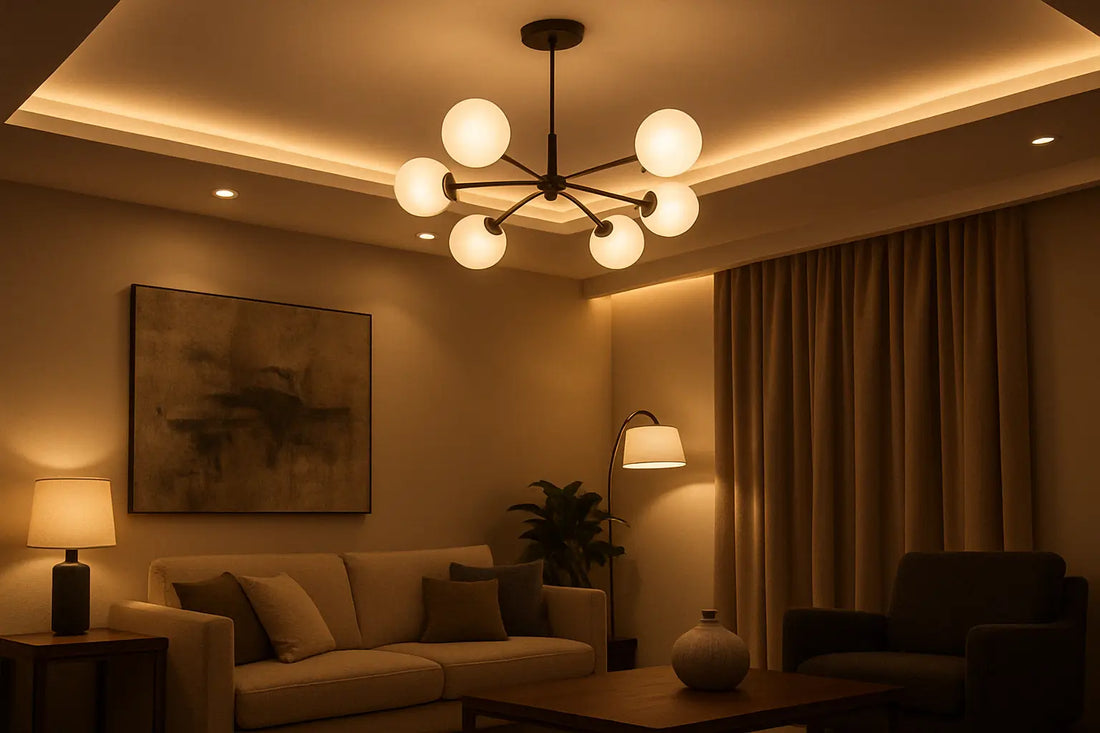
Ceiling Lighting in Interior Design: Types and Applications
Share
Ceiling Lighting in Interior Design: Types and Applications
Lighting is not just about illumination—it's the hidden thread that ties your entire space together. And when it comes to interior design, ceiling lighting plays the starring role. From setting the tone of a room to making a statement, the lights above our heads can either elevate a space—or leave it feeling incomplete.
In this guide, we’ll explore the main types of ceiling lighting and how they can be thoughtfully applied to create ambiance, enhance functionality, and express your unique style.
1. Why Ceiling Lighting Matters More Than You Think
Ceiling lighting is often the primary light source in any room, but its impact goes far beyond brightness. It shapes shadows, defines zones, influences moods, and even affects our energy levels and sleep cycles.
Whether you're designing a cozy bedroom, a productive home office, or a vibrant living room, the right ceiling lighting makes all the difference.
2. The Main Types of Ceiling Lights
Let’s break down the most common ceiling lighting options and their unique features:
A. Flush Mount & Semi-Flush Mount Lights
- Flush mount: Installed directly against the ceiling, great for low ceilings and minimalistic looks.
- Semi-flush mount: Hangs slightly below the ceiling, offering a bit more flair while still saving space.
- Best for: Bedrooms, hallways, closets, or any room with low clearance.

B. Pendant Lights
- These are suspended from the ceiling by a rod, cord, or chain.
- They come in endless styles—from industrial to boho—and add personality and drama to a room.
- Best for: Kitchen islands, dining areas, reading corners, and entryways.

C. Chandeliers
- Grand, elegant, and often luxurious, chandeliers are focal points.
- Modern designs range from sleek minimalism to bold artistic shapes.
- Best for: Living rooms, dining rooms, or anywhere you want to make a statement.

D. Recessed Lighting
- Installed into the ceiling so they sit flush, offering a clean and modern look.
- Can be used in multiples for general lighting or directional task lighting.
- Best for: Kitchens, bathrooms, and open-plan living areas.

E. Track Lighting
- Lights mounted on a track system that allows repositioning and angling.
- Great for highlighting artwork or architectural features.
- Best for: Galleries, workspaces, or modern living rooms.

F. Cove and Indirect Lighting
- Hidden within architectural elements to cast a soft glow.
- Creates a cozy, ambient vibe without harsh direct light.
- Best for: Bedrooms, lounges, or behind crown molding and ceilings.

3. How to Choose the Right Type for Each Room
Each space in your home serves a different purpose—and the ceiling lighting should reflect that.
|
Room |
Recommended Lighting Type |
Why It Works |
|
Bedroom |
Semi-flush + Indirect/Cove Lighting |
Creates a soft, relaxing atmosphere |
|
Kitchen |
Recessed + Pendant |
Functional yet stylish lighting for key areas |
|
Living Room |
Chandelier or Track Lighting + Floor lamps |
Layered lighting for flexibility and coziness |
|
Bathroom |
Flush Mount + Recessed |
Bright and efficient for daily routines |
|
Entryway |
Pendant or Chandelier |
Sets the tone and makes a first impression |
4. Ceiling Lighting & Emotional Wellbeing
The emotional effects of lighting are often underestimated. Warm-toned ceiling lights can promote calmness and intimacy, while cooler tones help increase alertness and productivity. Indirect ceiling lighting, like hidden cove lights, can subtly elevate your mood, making your home feel like a comforting retreat.
Some ceiling lights even combine aromatherapy features or color transitions, enhancing the sensory experience—perfect for modern lifestyles that blend function and wellness.
5. Creating Atmosphere with Light Layers
A well-designed lighting plan doesn't rely on just one source. Combine ceiling lights with wall sconces, table lamps, and even decorative diffusers to create layers of light. This approach gives you flexibility depending on the time of day, activity, and emotional vibe you want to create.
Remember: ceiling lighting should not dominate but collaborate with other sources to paint the perfect scene.
6. Trends in Ceiling Lighting You’ll Love
- Sculptural forms replacing traditional designs
- Smart lighting with app or voice control
- Eco-friendly LED integrations
- Natural textures like bamboo and wood for warm, earthy tones
- Multifunctional designs that combine lighting, scent, and even art
These trends allow you to explore new styles while maintaining harmony in your home’s design language.
7. Final Thought: Let the Ceiling Tell Your Story
Your ceiling lighting is more than functional—it’s a design statement. It reflects your lifestyle, mood, and sense of beauty. When thoughtfully chosen, it can transform a space, evoke emotion, and bring balance to your daily life.
Next time you look up, imagine what your ceiling could say if it had a voice.